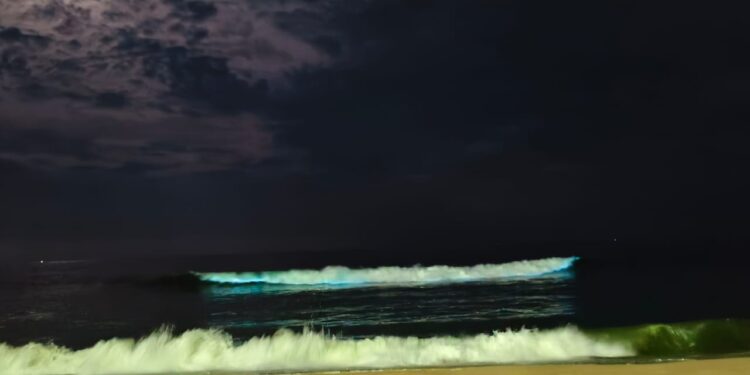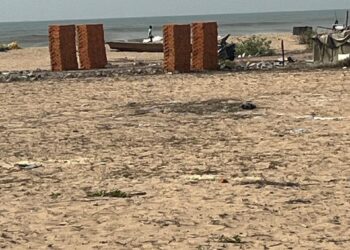On Oct.19 and 20, the Chennai beaches were washed by blue-illuminated waves. This is not the first instance for Chennai. An earlier instance was reported in August 2019. Here is a report from that time.
When the beach was illuminated blue
Late Aug 18, many visitors to the Thiruvanmiyur beach noticed bright blue luminescent waves hitting the beaches. Soon the social media was flooded with pictures of the phenomenon and the beaches pulled visitors in awe.
Dr. P. Nammalwar, Former Principal Scientist – Central Marine Fisheries Research Institute – ICAR, Govt of India, explained, “This event was caused by a particular variety of plankton that bloom in warm waters. There has been a rise in the temperature of the sea lately thus attracting the plankton. These plankton deplete the oxygen levels in the ocean / sea causing death among fishes.”
T.D. Babu, SPARK, further explained, “The blue luminance of the beach was caused by a particular variety of plankton – Noctiluca scintillans. Its bloom is an alarm that we have been polluting our waters with trash cause ocean temperatures to rise.”
Noctiluca scintillans, commonly known as the sea sparkle is one of the most commonly occurring bioluminescent organisms in coastal regions of the world. It exhibits bioluminescence when disturbed during bloom (population increase).
According to the Marine Species Identification Portal, “Toxic blooms of N. Scintillans have been linked to massive fish and marine invertebrate kills. Although this species does not produce a toxin, it has been found to accumulate toxic levels of ammonia which is then excreted into the surrounding waters possibly acting as the killing agent in blooms. Extensive toxic blooms have been reported off the east and west coasts of India, where it has been implicated in the decline of fisheries.”
According to a research paper in https://www.ias.ac.in, “Aiyar (1935) observed in June 1935 mortality in fish and marine animals near Madras caused by the occurrence of Noetiluca in exceptional abundance. He surmised that the mortality was due to the rapid utilisation by the organisms of available oxygen in sea water.”
Speaking to Adyar Times again about the bio-luminescence, marine biologist T.D.Babu explained, “This is the result of eutrophication, excessive pollution into the sea in the form of sewage, and industrial effluents. These high nutrient levels trigger the population explosion of phytoplankton.” He further explained that the repeated incidents of such planktonic blooms in the sea only indicate that there is a continuous rise in pollution, which has to be addressed immediately. Apart from sewage and industrial effluent, the surface runoff has also contributed to high organic load indicating mismanagement of solid waste management.
Environmental activist Nityanand Jayaraman also shared about this phenomenon on his Facebook page. Sharing his interaction with an expert senior fisherman from Urur Olcott Kuppam, Palayam Anna, the post reads…
Palayam explained, “This phenomenon can be observed when polluted water is washed ashore. Such occurrences are more likely to occur when pollutants are not carried away by currents and drift along the coast. We call this ‘Kamaru’. When this happens, bio-luminescence is produced and the fish will come towards the shore in search of light. Kamaru is always present in the ocean.
Saying that, Palayam took us to the place where the waves meet. He dug a hole in the soil using both hands. After the tide came and went, he stirred the water in the pit. Kamaru could be seen flashing.
Bio-luminescence is a communication system that many organisms (algae, fish, algae) use in the ocean. A few of the flying fish species also have a bio-luminescent insect on the side of their gills, which lives as long as the fish survives. Phytoplankton produce light using a molecule called luciferin when the waves are agitated. Algae like this is always present in seabed, but only when it becomes abundant, this phenomenon occurs.
I asked Palayam why the intensity of the event, which was significantly observed from Kovalam to Thiruvanmiyur, was less on the coast of Besant Nagar Uroor Kuppam. He said, “Due to the flow of water from the Adyar River, the seawater near the mouth (including Elliot’s beach) was diluted and the polluted water was taken to the northern and southern parts of the beach due to currents. However, due to the high level of pollution at the mouth of Adyar River, the bio-luminescence gave a ghostly appearance there.
The bio-luminescence, that has been spotted currently, is reported to be visible till Sadras (Kalpakkam). It’s ironic that Kovalam, which has been certified as a Blue-Flag beach, is living up to its name now! The recurrence of bio-luminescence only highlights that more serious efforts need to be put into cleaning and maintaining our water bodies. The cleaning of our rivers needs to be expedited and the Solid Waste Management Rules (2016) must be implemented strictly.
Though the bio-luminescence is a sight to behold, one must remember that it is not a phenomenon to be proud of!











